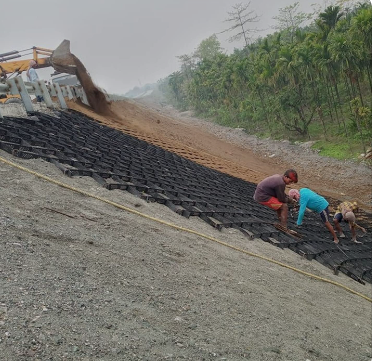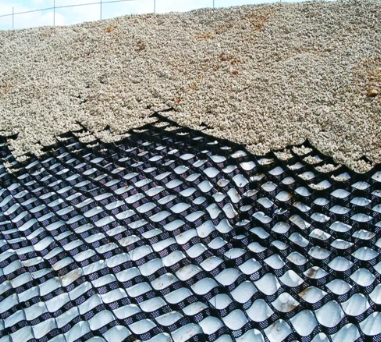- Understanding the Role of Geomembrane Liners in Waste Management
- Innovations in Geomembrane Liners for Water Management
- Geomembrane Liners: A Comprehensive Guide
- The Future of Geomembrane Liners in Civil Engineering
- Geomembrane Liners: Enhancing Landfill Stability
Manager:
WhatsApp:+86 177 0135 2670
Tel:+86 177 0135 2670
Email:marketing@okorder.com
Address:3rd Floor, No.2 Building, No.1 Sanlihe Road
Can you fill geocell with concrete?
In the realm of civil engineering and environmental conservation, slope protection is a critical concern. Erosion, soil instability, and the effects of weathering pose significant challenges to the integrity of slopes, potentially leading to landslides, loss of habitat, and infrastructure damage. To combat these issues, innovative solutions like geocell slope protection have gained traction. But can you fill geocell with concrete, and how effective is it in slope protection?

Understanding Geocell Slope Protection
Before delving into the question of filling geocell with concrete, let's first grasp the concept of geocell slope protection. Geocells, also known as cellular confinement systems, are three-dimensional, honeycomb-like structures made from high-density polyethylene (HDPE) or other durable materials. These cells are interconnected and filled with soil, aggregate, or other suitable materials to create a stable structure.
The Functionality of Geocell in Slope Protection
Geocell slope protection works by confining the infill material within its cells, effectively increasing soil shear strength and preventing erosion. When installed on slopes, geocells provide structural reinforcement, distributing loads more evenly and reducing the risk of slope failure. Additionally, the confinement offered by geocells promotes vegetation growth, further enhancing slope stability and ecological restoration efforts.
Benefits of Geocell Slope Protection
Geocell slope protection offers several advantages over traditional slope stabilization methods:
1. Cost-effectiveness: Geocell installations are often more economical than traditional methods like riprap or concrete retaining walls, especially in challenging terrain where access is limited.
2. Flexibility: Geocells can conform to irregular slope surfaces and accommodate various infill materials, allowing for tailored solutions to specific site conditions.
3. Environmental sustainability: By promoting vegetation growth and reducing the need for extensive earthworks, geocell slope protection minimizes environmental disturbance and enhances ecological resilience.
4. Longevity: Properly designed and installed geocell systems can provide durable slope protection for decades, with minimal maintenance requirements.
Can Geocell be Filled with Concrete for Slope Protection?
Now, back to the central question: can you fill geocell with concrete? While geocells are typically filled with soil, aggregate, or a mixture of both, using concrete as an infill material is indeed a possibility in certain applications.
Suitability of Concrete Fill
Concrete fill in geocells is most commonly employed in situations where additional weight, stability, or erosion resistance is required. For instance, in shoreline protection projects or areas prone to high-flow velocities, concrete-filled geocells can offer enhanced durability and resistance to hydraulic forces.
Benefits and Considerations of Concrete-Filled Geocells
1. Increased Weight and Stability: Concrete-filled geocells provide greater mass and resistance to overturning, making them suitable for applications where slope stabilization is paramount.
2. Erosion Resistance: The impermeability of concrete helps mitigate erosion caused by water flow, making it an effective solution for protecting slopes in waterways or coastal areas.
3. Engineering Flexibility: Concrete-filled geocells can be engineered to meet specific design requirements, including load-bearing capacity, slope angle, and environmental conditions.
However, it's essential to consider certain factors before opting for concrete-filled geocells:
1. Installation Challenges: The installation of concrete-filled geocells may require specialized equipment and expertise, particularly in remote or challenging terrain.
2. Environmental Impact: While concrete-filled geocells offer excellent erosion resistance, their use may impact local ecosystems and biodiversity. Proper mitigation measures should be implemented to minimize environmental harm.
3. Cost Considerations: Concrete fill may incur higher material and installation costs compared to traditional infill materials like soil or aggregate. Project budget and cost-effectiveness should be carefully evaluated.

Conclusion
In conclusion, while geocells are typically filled with soil or aggregate for slope protection applications, filling them with concrete is indeed feasible and offers certain advantages in specific scenarios. Concrete-filled geocells provide increased weight, stability, and erosion resistance, making them suitable for challenging terrain and high-flow environments. However, careful consideration of installation requirements, environmental impacts, and cost-effectiveness is essential to determine the suitability of concrete-filled geocells for a particular slope protection project. Ultimately, whether to fill geocell with concrete depends on site-specific conditions, engineering considerations, and project objectives."
- Previous:What do you fill geocell with?
- Next:Is Geocell worth it?






